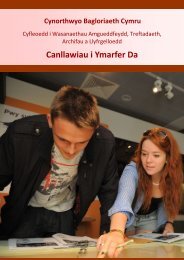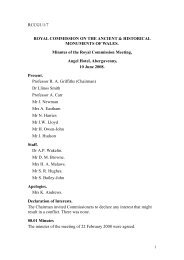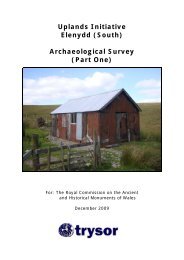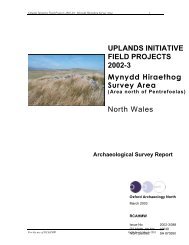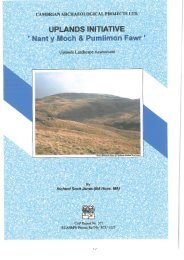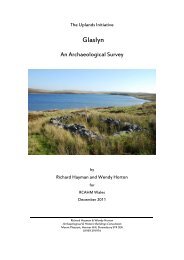Beacon Hill, Radnorshire - Royal Commission on the Ancient and ...
Beacon Hill, Radnorshire - Royal Commission on the Ancient and ...
Beacon Hill, Radnorshire - Royal Commission on the Ancient and ...
Create successful ePaper yourself
Turn your PDF publications into a flip-book with our unique Google optimized e-Paper software.
RCAHM Wales Upl<strong>and</strong>s Initiative – <str<strong>on</strong>g>Beac<strong>on</strong></str<strong>on</strong>g> <str<strong>on</strong>g>Hill</str<strong>on</strong>g>2.0 MethodologyThe project aimed to rapidly identify <strong>and</strong> record <strong>the</strong> archaeological resource throughsystematic field survey. Archaeological remains of all periods were c<strong>on</strong>sideredequally. RCAHM Wales undertook aerial photograph mapping of <strong>the</strong> area, which wasc<strong>on</strong>sulted throughout <strong>the</strong> fieldwork phase. The regi<strong>on</strong>al Sites <strong>and</strong> M<strong>on</strong>uments Recordwas also c<strong>on</strong>sulted prior to <strong>the</strong> fieldwork <strong>and</strong> RCAHMW also provided digital copiesof <strong>the</strong> County series of Ordnance Survey maps. Ti<strong>the</strong> surveys of Beguildy <strong>and</strong>Llanbister parishes, <strong>and</strong> <strong>the</strong> 1830 Ordnance Survey map of Britain, were alsoc<strong>on</strong>sulted, but a search did not discover any estate maps covering <strong>the</strong> area.The area was divided into transects 30m apart, except in areas where remains weresparse. These were divided into 50m transects. The locati<strong>on</strong> (NGR) <strong>and</strong> altitude ofevery site was established by a h<strong>and</strong>-held Global Positi<strong>on</strong>ing System receiver. Writtendescripti<strong>on</strong>s, including approximate dimensi<strong>on</strong>s, were made in <strong>the</strong> field <strong>and</strong>photographs were taken of all important sites <strong>and</strong> when <strong>the</strong> c<strong>on</strong>diti<strong>on</strong>s werefavourable.The terrain changes significantly between spring <strong>and</strong> autumn, especially in <strong>the</strong> 300-400m c<strong>on</strong>tour b<strong>and</strong> where <strong>the</strong>re is dense bracken. By late summer <strong>the</strong> vegetati<strong>on</strong>cover, especially bracken, inhibited <strong>the</strong> identificati<strong>on</strong> of some sites at <strong>the</strong> south-westend of <strong>the</strong> survey area.3.0 Results of SurveyA total of 422 sites were identified in a survey area of 17 square kilometres, giving adensity of 24.8 sites per square kilometre (table 1). An abbreviated table of sites,giving informati<strong>on</strong> <strong>on</strong> type, period <strong>and</strong> altitude, is provided in Appendix 1.C<strong>on</strong>tour B<strong>and</strong> (m) Area (km 2 ) No. Sites Density(per km 2 )251-300 0.01 0 0301-350 0.3 20 66.6351-400 3.1 153 49.3401-450 7.1 184 25.9451-500 5.3 52 9.8501-550 1.2 13 10.8Total 17 422 24.8Table 1: Sites grouped by c<strong>on</strong>tour2



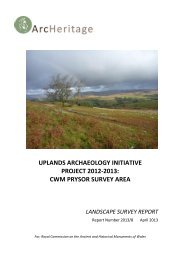
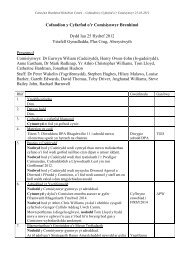
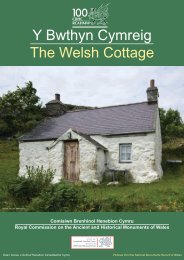

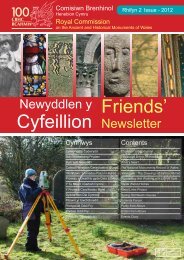
![The Source of the Usk Walk [2012 PDF]](https://img.yumpu.com/49285699/1/190x245/the-source-of-the-usk-walk-2012-pdf.jpg?quality=85)

